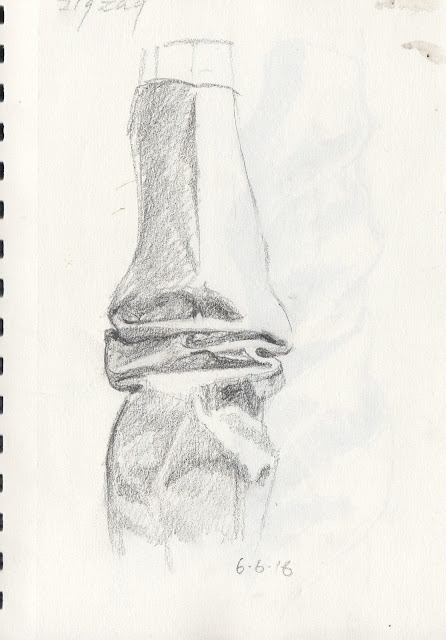 |
Diego Velazquez, "Old Woman Frying Eggs," 1619. A bodegon.
|
Like most, a great deal of my work once was still life. A still life is simply a drawing or other image of a group of inanimate objects. It doesn't matter if they once were animate; they are not at the moment they're caught in the image. Certain paintings that do contain an animate object are also considered still life--an example is the Spanish bodegon or kitchen painting, that often has a figure or two. But usually when we think of still life we think of the inanimate.
Still life is a great way for beginners to work because everything can be arranged, not just the objects themselves but their lighting and surroundings. Many painters have some kind of light box with three sides that can be set up rather in the way movies are set up. The painter can juxtapose green apples, red peppers, an orange, and a glass of water, for example, in a pleasing arrangement and paint the result. Contemporary painters do just that, but in the past the idea wasn't simply to show a pleasing arrangement or show one's technical skills.
 |
Hoff, "Risk Factors," oil on panel, 2008
|
From the 16th century into our own time, still lifes have served as metaphors. One important type of still life is the vanitas, a reminder of our universal mortality. Vanitas refers to a phrase from Ecclesiastes "vanitas vanitatum, omnia vanitas"--that is, "vanity of vanities, all is vanity." Vanitas paintings often include symbols of transience such as soap bubbles, a skull, a snuffed candle. Other kinds of still life have show opulent spreads of food and drink--known as "breakfast paintings" in Holland at that time. Even these sumptuous, rather decadent images contain hidden meanings.
 |
Rembrandt, "Side of Beef," oil on panel, 1655
|
Some still life isn't easily classified. For example, Rembrandt's "Slaughtered Ox," now in the Louvre, does show a inanimate object, this time a side of beef in a slaughterhouse. The painting is relatively small but has an enormous impact. It is indeed classified as a still life, but carries an implicit message about life and its transience. Why the great Dutch painter made this painting remains unknown, but it has inspired others--notably Chaim Soutine and Francis Bacon.
 |
Hoff, "Onion," oil on panel, 2011
|
Still life is clearly more than a collection of objects. But sometimes that's all it is. Many beginning painters have tackled the subject of a ripe apple, or a pear, or a glass of wine, or even all three in the same painting. For practice a good idea is to include objects that echo solid geometric shapes--spheres, cylinders, cubes and similar solids, pyramids, and so on.
 |
Hoff, "Bedtime Snack," oil on panel, 2006
|
One great way to build momentum in the studio is to do small, daily studies of various objects like that apple (left), or perhaps a glass of milk (below). The daily painting habit plus the use of small support sizes means that you can practice without worrying over time and expense or getting to precious about each individual work.
For anyone who wants to advance skills in all phases of painting or drawing, give daily still life painting a try.






















